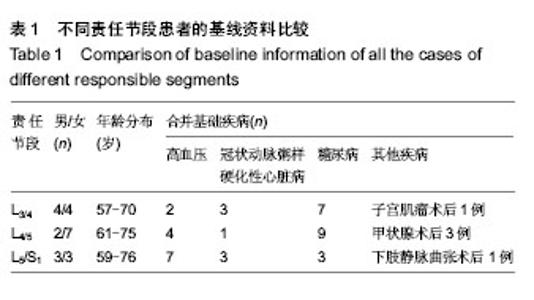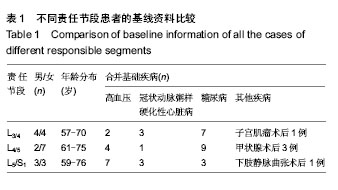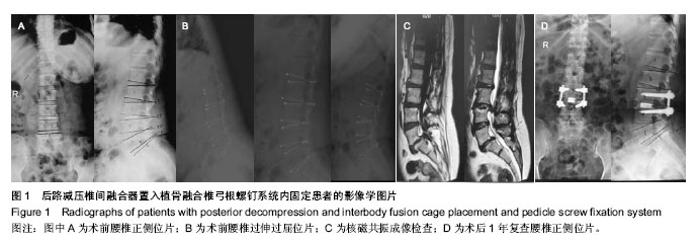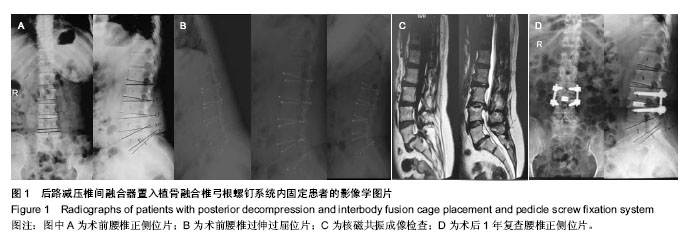| [1] 李勤,田伟,刘波,等.老年腰椎手术及围手术期治疗特点[J].中华外科杂志,2002,6(40):448-450.
[2] 崔显峰,朱悦.退行性腰椎不稳定的诊断研究进展[J].中华骨科杂志,2007,7(27):539-542.
[3] 徐宏光,王以朋,邱贵兴,等.腰椎管狭窄症伴不稳定性腰椎退变性滑脱的手术治疗[J].中华外科杂志,2002,10(40):723-727.
[4] 翁习生,邱贵兴,张嘉,等.椎弓根内固定技术的远期疗效评价[J]. 中华骨科杂志,2001,11(21):662-665.
[5] 文睿,王清.椎间植骨融合内固定与三柱植骨融合内固定治疗退行性腰椎不稳症的疗效比较[J].中国综合临床, 2010,2(26): 196-199.
[6] 孙永生,梁朝,温建民.腰椎融合及其临床应用策略[J].中华临床医师杂志:电子版, 2011,8(16):4621-4626.
[7] 颜连启,宦诚,孙钰,等.腰椎融合固定和非融合固定生物力学分析[J].中华临床医师杂志:电子版,2011,8(15):4432-4437.
[8] 石洋,常楚,杨璐,等.后外侧植骨融合与后路椎间植骨融合治疗腰椎退行性疾病的疗效评价[J].中华临床医师杂志:电子版, 2011, 4(8):2394-2398.
[9] Goldstein CL,Macwan K,Sundararajan K,et al. Comparative Outcomes of Minimally Invasive Surgery for Posterior Lumbar Fusion:A Systematic Review. Clin Orthop Relat Res. 2014.
[10] Ntoukas V,Muller A. Minimally invasive approach versus traditional open approach for one level posterior lumbar interbody fusion. Minim Invasive Neurosurg. 2010;53(1): 21-24.
[11] Lee KH,Yue WM,Yeo W,et al. Clinical and radiological outcomes of open versus minimally invasive transforaminal lumbar interbody fusion. Eur Spine J. 2012;21(11):2265-2270.
[12] Park P,Garton HJ,Gala VC,et al. Adjacent segment disease after lumbar or lumbosacral fusion:review of the literature. Spine. 2004;29(17):1938-1944.
[13] Xia XP,Chen HL,Cheng HB. Prevalence of adjacent segment degeneration after spine surgery. Spine. 2013;38 (7):597-608.
[14] Guyer RD,McAfee PC,Banco RJ,et al. Prospective, randomized, multicenter Food and Drug Administration investigational device exemption study of lumbar total disc replacement with the CHARITE artificial disc versus lumbar fusion: five-year follow-up. Spine J. 2009;9:374-386.
[15] Elfering A,Semmer N,Birkhofer D,et al. Risk factors for lumbar disc degeneration:a 5-year prospective MRI study in asymptomatic individuals. Spine. 2002;27:125-134.
[16] Wai EK,Santos ER,Morcom RA,et al. Magnetic resonanceimaging 20 years after anterior lumbar interbody fusion. Spine. 2006;31:1952-1956.
[17] Lawrence BD,Wang J,Arnold PM,et al. Predicting the Risk of Adjacent Segment Pathology After Lumbar Fusion. Spine. 2012;37(22):123-132. |



